Henry Augustus Lukeman
Henry Augustus Lukeman (January 28, 1872 – April 3, 1935) was an American sculptor, specializing in historical monuments.
Noted among his works are the World War I monument in Prospect Park, Brooklyn, the Kit Carson Monument in Trinidad, Colorado and the Stone Mountain Confederate Memorial in Georgia.
Biography
Early life and education
Henry Augustus Lukeman was born on January 28, 1872,[citation needed] in Richmond, Virginia,[page needed] and was raised in New York City. He is "said to have begun lessons at the National Academy and the Cooper Union School at age eleven," though a National Academy of Design source notes that the school's "registration records do not bear… out" this historical supposition. It is also reported[by whom?] that he began sculpting at age 10 at a boys' club miniature workshop, working in clay and wood from ages 10 to 13.[citation needed]
At a young age he became a studio assistant of Launt Thompson, an Irish-American sculptor and National Academician, and, like Launt, pursued medically related studies (anatomy)—Lukeman at New York's Bellevue Hospital (for two year prior to 1890). He remained with Launt until age 16.[verification needed] There is report,[by whom?] potentially conflicting with other sources regarding his early training, that has him involved in an apprenticeship at the foundry of Jno. Williams, Inc. until he was 19.[citation needed] Likewise regarding a further report:[by whom?] that Lukeman studied terra cotta and architectural modeling for building and exterior decorations for several years,[when?] while in the evening studying life drawing (at the Cooper Union in New York).[citation needed] Lukeman is known to have attended classes at the National Academy for Design beginning in 1890, where records exist for his registration for the antique school (for two years), and to have followed this with study at Columbia University. Following that he went to Europe for 6 months and worked under Jean-Alexandre-Joseph Falguiere, at the Beaux Arts, in Paris.[verification needed]
When Lukeman returned to New York, he became an assistant to Daniel Chester French, a commitment that would last for a decade and a half, during which time he would also begin to execute his own commissions, eventually opening his own studio in New York.[when?][citation needed] When construction of the World's Columbian Exposition began in 1893, Lukeman would superintend enlarging some important works for French,[citation needed] for instance, the Statue of the Republic.
American works

This section needs additional citations for verification. (September 2015) |

Lukeman's independent work began in this new studio, and included the monuments in which he would come to specialize, as well as "portrait busts and statues, bas-reliefs, ornamental sculpture," which have been described as being "architecturally effective and often remarkable in conception." Notable works in New York state from his early independent work include figures for the Customs Building in Columbus,[citation needed] on the Appellate Court House in Manhattan, and on the facade of the Brooklyn Institute of Arts and Sciences. A further more complete list of his American and Canadian commissions and other important public sculpture works is given below.
A seminal work of Lukeman—proceeding from his earlier work on "several grandiose memorials"—was to complete the execution of the enormously scaled Stone Mountain Confederate Memorial. This mountain carving depicted the confederacy's president, Jefferson Davis, and Generals Robert E. Lee and Thomas J. "Stonewall" Jackson (and their respective horses Blackjack, Traveller, and Little Sorrel), in DeKalb County, Georgia, near Atlanta;[citation needed] there, Lukeman designed and supervised sculpting of the monument after removing the earlier work of Gutzon Borglum (the original commissionee, who had resigned). David Dearinger notes that "Lukeman was criticized for taking over another artist's work," and that "he used Borglum's existing scheme," though altering it to be a bas-relief whose figures would ultimately be over 150 feet tall.
When funding ran out in the advent of the Great Depression, Lukeman would continue to pay the craftsmen until his own means were exhausted,[citation needed] after which the carving would remain incomplete for decades (until Walker Hancock and Roy Faulkner completed an edited version of the Lukeman design in 1970).[citation needed] Located 400 feet (120 m) above ground, and lacking the originally intended legs on the horses, the Lukeman-Hancock-Faulkner sculpture ultimately measured 190 by 90 feet (58 by 27 m), and is recessed 42 feet (13 m).[citation needed]
Lukeman died in New York on April 3, 1935, aged 65,[citation needed] leaving his wife, formerly, Helen Bidwell Blodgett.[citation needed]
Honors and awards
This section needs expansion with: a fully sourced, expanded presentation to replace this unsourced and non-comprehensive stub of Lukeman awards. You can help by adding to it. (September 2015) |
Lukeman's work was recognized by the Henry Street Settlement,[when?][citation needed] and he was given an honorary Doctor of Humane Letters from Dickinson College.[when?][citation needed]
Influences, and those influenced
This section needs expansion with: a more fully sourced, expanded treatment of those influencing, and being influenced by Lukeman. You can help by adding to it. (September 2015) |
Two significant influences were those whose training he extensively received, Launt Thompson and Daniel Chester French.[citation needed] In addition, Lukeman was known to have kept a small nude study executed by Kenyon Cox,[verification needed] one which "Cox considered among his best," and is therefore considered as one of Lukeman's possible artistic influences.
Public sculptures
Dated entries
The following entries, whose dates of execution are known, are ordered according to date, earliest to latest:
- Manu, the Law Giver of India, 1899, on the Appellate Division Courthouse of New York State, New York City.
- Music (Festival Hall) and another decorative sculpture (Electrical Building), at the Saint Louis Exposition, 1904, Saint Louis, Missouri; awarded a medal.[clarification needed][citation needed]
- The Hebrew Law Giver, Psalmist, Apostle, and Prophet (4 figures, facade), 1907–1909,[citation needed] the Brooklyn Institute of Arts and Sciences, New York.
- The Straus Memorial in Straus Park, Manhattan, New York City, 1915;[citation needed] dedicated to Ida and Isidor Straus, who lost their lives on the RMS Titanic.[better source needed]
- Pulitzer Prize gold medal (with Daniel Chester French), 1918.
- The Prospect Park Memorial, 1921, a World War I monument, in Prospect Park, Brooklyn.
- Major General David McMurtrie Gregg, 1922, Reading, Pennsylvania.
- The Soldiers and Sailors Monument, 1923, Pittsfield, Massachusetts; refurbished, with presentation, Memorial Day 2010.
- Stone Mountain Confederate Memorial, DeKalb County, Georgia, near Atlanta, 1925–1928;[citation needed] preceded in this project by Gutzon Borglum,[citation needed] and followed by Walker Hancock.[citation needed]

Fuller E. Callaway, 1929, textile magnate portrait bust, Hills & Dales Estate, LaGrange, Georgia
Undated entries
This section needs additional citations for verification. (September 2015) |


The following entries, whose dates of execution are unknown, are ordered alphabetically by the subjects surname or place name:
- Francis Asbury Equestrian Sculpture, Washington, D.C.[citation needed]
- Francis Asbury Statue, Madison, New Jersey.[citation needed]
- Daniel Boone bas-relief portrait, Paris, Kentucky.[citation needed]
- Kit Carson Monument in Trinidad, Colorado; figure of Carson; sculptor Frederick Roth executed the horse.[citation needed]
- Lieutenant Cushing, on the Dewey Arch, New York, New York.[citation needed]
- Customs Building, Columbus, New York.[citation needed]
- Ulysses S. Grant Memorial, San Diego, California.[citation needed]
- Joseph Henry, professor, Princeton University, Princeton, New Jersey.
- Robert Livingston, Saint Louis, Michigan.
- President William McKinley Statue, Adams, Massachusetts.
- President William McKinley Statue, Toledo, Ohio.[citation needed]
- Memorial to the Women of the Confederacy, Raleigh, North Carolina.[citation needed]
- National Sculpture Society Seal.[citation needed]
- Pan-American Exposition sculpture, in Buffalo, New York.[citation needed]
- James K. Patterson, early president of the University of Kentucky, Lexington, Kentucky.[citation needed]
- President Franklin Pierce, New Hampshire State Capitol, Concord, New Hampshire.
- Royal Bank of Canada headquarters, four colossal statues, Montreal, Quebec, Canada.
- General William Shepard, Westfield, Massachusetts.[citation needed]
- Soldiers and Sailors Monument, Public Square, Watertown, New York.[citation needed]
- Soldiers’ Monument, Somerville, Massachusetts.
- Elisha Yale, at Gloversville, New York.
References
![]() This article incorporates text from a publication now in the public domain: Gilman, D. C.; Peck, H. T.; Colby, F. M., eds. (1905). "Lukeman, Henry Augustus (1870–)". New International Encyclopedia (1st ed.). New York: Dodd, Mead., as reflected by the inline references to Colby & Williams, (1915), New International Encyclopedia (2nd ed.), op. cit.
This article incorporates text from a publication now in the public domain: Gilman, D. C.; Peck, H. T.; Colby, F. M., eds. (1905). "Lukeman, Henry Augustus (1870–)". New International Encyclopedia (1st ed.). New York: Dodd, Mead., as reflected by the inline references to Colby & Williams, (1915), New International Encyclopedia (2nd ed.), op. cit.
Further reading
- David Bernard Dearinger, ed. (2004) Paintings and Sculpture in the Collection of the National Academy of Design: 1826-1925 (Volume 1), pp. 123f, New York, NY: Hudson Hills, ISBN 1555950299, see [8] and [9], accessed 12 September 2015.
- Anon. (1935), "Obituary: [Henry Augustus] Lukeman is Dead, A Noted Sculptor; Succeeded Borglum as Designer of Stone Mountain Memorial to Confederacy," The New York Times (online), Thursday April 4, 1935, see [10], accessed 12 September 2015.[Subscription required]
- The Smithsonian (2015), "Research Collections, L: Henry Augustus Lukeman papers, circa 1891-1935 (summary)," Smithsonian Archives of American Art, (online), see [11], accessed 12 September 2015. Collection size, 0.50 linear feet (0.15 m), Full access at the Washington, D.C., Research Center.
- The Times-Dispatch, Richmond, Virginia, May 10, 1903.[full citation needed]
External links
This article uses material from the Wikipedia English article Henry Augustus Lukeman, which is released under the Creative Commons Attribution-ShareAlike 3.0 license ("CC BY-SA 3.0"); additional terms may apply (view authors). Content is available under CC BY-SA 4.0 unless otherwise noted. Images, videos and audio are available under their respective licenses.
®Wikipedia is a registered trademark of the Wiki Foundation, Inc. Wiki English (DUHOCTRUNGQUOC.VN) is an independent company and has no affiliation with Wiki Foundation.





